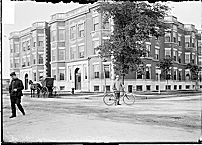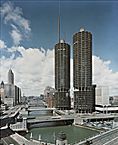| Entries |
| A |
|
Apartments
|
From Chicago's earliest experience with multifamily residences until the 1930s, the single-family house remained the norm for a home. Thus, the exterior appearance of flats, apartment buildings, and residential hotels tended to be inspired by whatever was current in the design of the better class of residence.

|
Only after 1900 did the number of multifamily buildings under construction exceed the number of single-family residences. Tall apartment buildings first appeared in 1882. Within a decade Clinton J. Warren had shown how elevator apartments could have a distinct visual appearance and functional character distinguishing them from hotels. The definitive form of the Chicago luxury apartment, attractive to people who had the means to live in a mansion, arrived in 1900 with Benjamin Marshall's Raymond Apartments at Michigan and Walton (destroyed). In 1911 Marshall built as his own investment the grandest of this group, 1550 North State Parkway. Dozens of others rising the canonic eight to twelve stories proliferated along the northern lakefront, often the design of Marshall, Howard Van Doren Shaw, or Hugh Garden.
After World War I, new laws allowed cooperative apartment ventures. Meanwhile, the 1923 zoning code allowed a generous building envelope along the lakefront. On the Gold Coast and in Hyde Park, the affluent middle classes and the wealthy built apartments reaching 23 stories and containing a variety of apartment configurations. Marshall and Shaw designed the best of them while Robert DeGolyer, William Ernest Walker, and McNally and Quinn stand out in the second rank.

|
The Encyclopedia of Chicago © 2004 The Newberry Library. All Rights Reserved. Portions are copyrighted by other institutions and individuals. Additional information on copyright and permissions.